Alternator not charging battery
Discussion
Hey guys,
My RX7 seems to have developed some electronic gremilins which are causing me a head ache.
Symptoms.
Battery, Oli Pressure and Coolant warning lights are on with ignition.
Voltage from the Alternator terminal to ground is 12.1v with engine running
Voltage across battery is 12.2v with engine running.
I have changed the alternator for a 2nd hand one and it does exactly the same thing so don't think the issue is mechanical (unless I am really unlucky!).
All the fuses seem to be fine, cleaned up battery terminals and clamps and have tried a 2nd battery from my MG.
The only thing I think is odd is the resistance of the negative battery cable. This cable bolts to the back of the alternator and clamps to the battery, I got a resistance reading of 1400 oms which is quite high.
Any ideas on where else to check?
My RX7 seems to have developed some electronic gremilins which are causing me a head ache.
Symptoms.
Battery, Oli Pressure and Coolant warning lights are on with ignition.
Voltage from the Alternator terminal to ground is 12.1v with engine running
Voltage across battery is 12.2v with engine running.
I have changed the alternator for a 2nd hand one and it does exactly the same thing so don't think the issue is mechanical (unless I am really unlucky!).
All the fuses seem to be fine, cleaned up battery terminals and clamps and have tried a 2nd battery from my MG.
The only thing I think is odd is the resistance of the negative battery cable. This cable bolts to the back of the alternator and clamps to the battery, I got a resistance reading of 1400 oms which is quite high.
Any ideas on where else to check?
Drop the alternator you removed into an auto electrical workshop, they should test it for free (we would anyway). Whilst it's there, ask them if it's a "smart" (ECU controlled) alternator.
If you get a clean bill of health, change the battery as a faulty battery may cause the alternator to fail to charge.
After this it's into the wiring and ECU (if smart).
ETA: I missed that you mentioned the high resistance in the earth cable, the resistance should be zero or thereabouts. A little strange that the earth bolts to the alternator, they are usually earthed through the engine block itself unless the alternator is an "isolated return" on ADR vehicles (tankers etc).
Simple test for this is to use one (neg really, but not important which) side of a jump lead, one end on the neg terminal of the battery and other end to the body of the alternator (or where the earth bolts to it).
Start the car and see if it's now charging. If it is, make up a new neg link cable.
HTH
John.
If you get a clean bill of health, change the battery as a faulty battery may cause the alternator to fail to charge.
After this it's into the wiring and ECU (if smart).
ETA: I missed that you mentioned the high resistance in the earth cable, the resistance should be zero or thereabouts. A little strange that the earth bolts to the alternator, they are usually earthed through the engine block itself unless the alternator is an "isolated return" on ADR vehicles (tankers etc).
Simple test for this is to use one (neg really, but not important which) side of a jump lead, one end on the neg terminal of the battery and other end to the body of the alternator (or where the earth bolts to it).
Start the car and see if it's now charging. If it is, make up a new neg link cable.
HTH
John.
Edited by jhfozzy on Monday 24th August 13:48
1400 ohms resistance in a cable earthing the block to the battery/chassis is way too high, I would expect less than 1 ohm!
Try connecting the alternator/block to the battery neg terminal with a jump lead, assuming the car runs a negative earth electrical system.
Try connecting the alternator/block to the battery neg terminal with a jump lead, assuming the car runs a negative earth electrical system.
Edited by Auntieroll on Sunday 23 August 22:24
You are, of course both/all correct, but until the battery/alternator share the same earth they do not have the same reference point, so, lets take it one step at a time, clear the obvious fault first & then see what are the symptoms.
Several years ago I had a similar issue which was solved by re-connecting a dodgy battery earth lead.
Once done as above with a jump lead, you should get 14.2 - 14.5 volts at the battery with the engine running.
Several years ago I had a similar issue which was solved by re-connecting a dodgy battery earth lead.
Once done as above with a jump lead, you should get 14.2 - 14.5 volts at the battery with the engine running.
OK guys,
I will admit I am a bit of a beginner when it comes to vehicle electrics but can someone just reassure me here....
I disconnected the negative clamp, put the jump lead on the negative terminal and then went to put the other end onto the alternator connector which resulted in the mother of all sparks. After checking my boxers I decided I would seek your guidance before trying again lol.
I will admit I am a bit of a beginner when it comes to vehicle electrics but can someone just reassure me here....
I disconnected the negative clamp, put the jump lead on the negative terminal and then went to put the other end onto the alternator connector which resulted in the mother of all sparks. After checking my boxers I decided I would seek your guidance before trying again lol.
Leave the battery negative terminal connected !
Attach one end of the jump lead to the engine block or ancillaries, being careful to run the lead clear of belts or fans etc,
Then attach the other end to the battery negative terminal.
Before you do this, check you have the reconnected the battery leads correctly,don't laugh, I was once called out to a 328GTS where the owner had managed to connect the battery barse ackwards.
Attach one end of the jump lead to the engine block or ancillaries, being careful to run the lead clear of belts or fans etc,
Then attach the other end to the battery negative terminal.
Before you do this, check you have the reconnected the battery leads correctly,don't laugh, I was once called out to a 328GTS where the owner had managed to connect the battery barse ackwards.
Lets start again, you could get lost in reading and attempting to follow all the above
Are you 100% sure that there is a cable running from the battery negative terminal to the alternator body?
Be sure that a negative battery clamp has not been fitted to the positive battery lead
It is unusual to have a negative cable running from the battery negative terminal to the alternator body
Bearing in mind that the starter motor earths through the main engine negative earth lead and much more current passes through the starter circuit compaired to the alternator circuit, I would expect the alternator to use the same engine earth as the starter motor
The alternator would have a seperate earth lead to it if it was rubber mounted, by that I mean if it was mounted using rubber bushes in its mounting holes and even then the alternator body would be earthed with a short lead to the engine
So now that you are aware that the alternator should be using the engine as an earth just the same as the starter motor does, unless it is rubber mounted.........see above..........start again
Be 100% sure that the alternator is earthed by a cable to the battery negative terminal
Once you are sure and you are sure that the cable has a resistance of 1400 Ohms.........Remove the cable and repair it or fit a new cable
If there is a bad earth at the alternator there is no point in pissing about with jump leads when you have already found the fault and could be spending that time fixing it
With everything switched off and the keys out of the ignition switch you should not have been getting big sparks from a jump lead........It may be the case that you are connecting negative to positive with that jump lead
Follow the above and you will not go wrong
Double check what you have been doing and be 100% sure before continuing........People often fit a negative battery clamp to the battery positive lead by mistake or because they did not have the correct positive battery clamp when needed
Be sure
Are you 100% sure that there is a cable running from the battery negative terminal to the alternator body?
Be sure that a negative battery clamp has not been fitted to the positive battery lead
It is unusual to have a negative cable running from the battery negative terminal to the alternator body
Bearing in mind that the starter motor earths through the main engine negative earth lead and much more current passes through the starter circuit compaired to the alternator circuit, I would expect the alternator to use the same engine earth as the starter motor
The alternator would have a seperate earth lead to it if it was rubber mounted, by that I mean if it was mounted using rubber bushes in its mounting holes and even then the alternator body would be earthed with a short lead to the engine
So now that you are aware that the alternator should be using the engine as an earth just the same as the starter motor does, unless it is rubber mounted.........see above..........start again
Be 100% sure that the alternator is earthed by a cable to the battery negative terminal
Once you are sure and you are sure that the cable has a resistance of 1400 Ohms.........Remove the cable and repair it or fit a new cable
If there is a bad earth at the alternator there is no point in pissing about with jump leads when you have already found the fault and could be spending that time fixing it
With everything switched off and the keys out of the ignition switch you should not have been getting big sparks from a jump lead........It may be the case that you are connecting negative to positive with that jump lead
Follow the above and you will not go wrong
Double check what you have been doing and be 100% sure before continuing........People often fit a negative battery clamp to the battery positive lead by mistake or because they did not have the correct positive battery clamp when needed
Be sure
Right just popped to the garage to double check everything again and get some photos. The batter is sat on 3.1v now, it was 11.98 last night and all we did was run the engine for 5 min which dropped the battery to 11.96.
Anyhow I have the battery on charge and will continue tests when it's back up to 12v.
There is no way to get the positive and negative the wrong way round as the positive terminal is attached to a fuse box and only moves 10mm.
Will get some bullet points and photos up shortly.
Anyhow I have the battery on charge and will continue tests when it's back up to 12v.
There is no way to get the positive and negative the wrong way round as the positive terminal is attached to a fuse box and only moves 10mm.
Will get some bullet points and photos up shortly.
Right me old muckers!
Here is tonights findings. Now I am not too sure how reliable they will be as the battery is now fully charged.
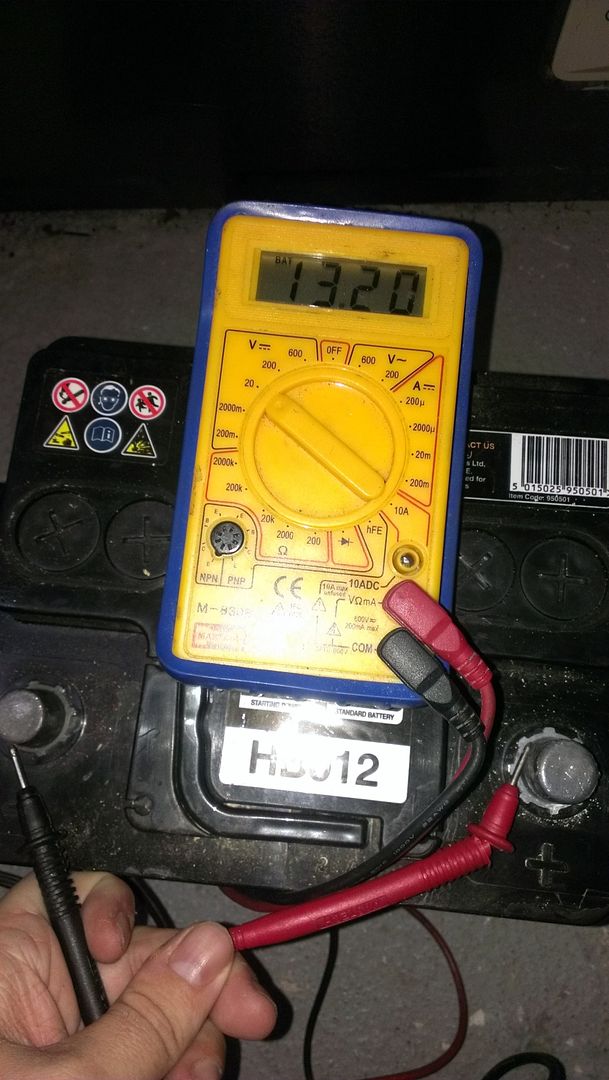
This is the layout of the Battery tray with the negative cable.
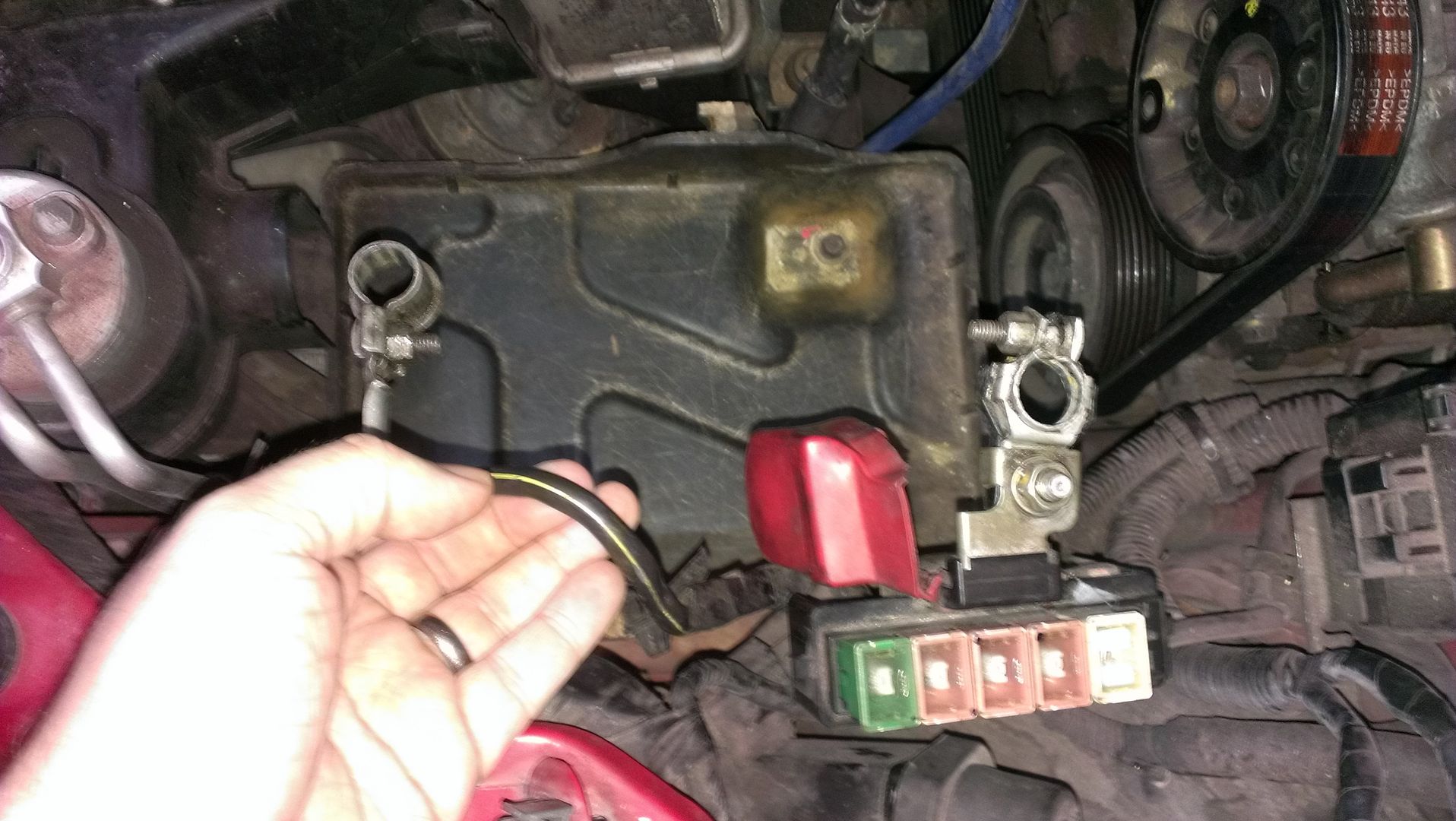
It goes off here to the body,
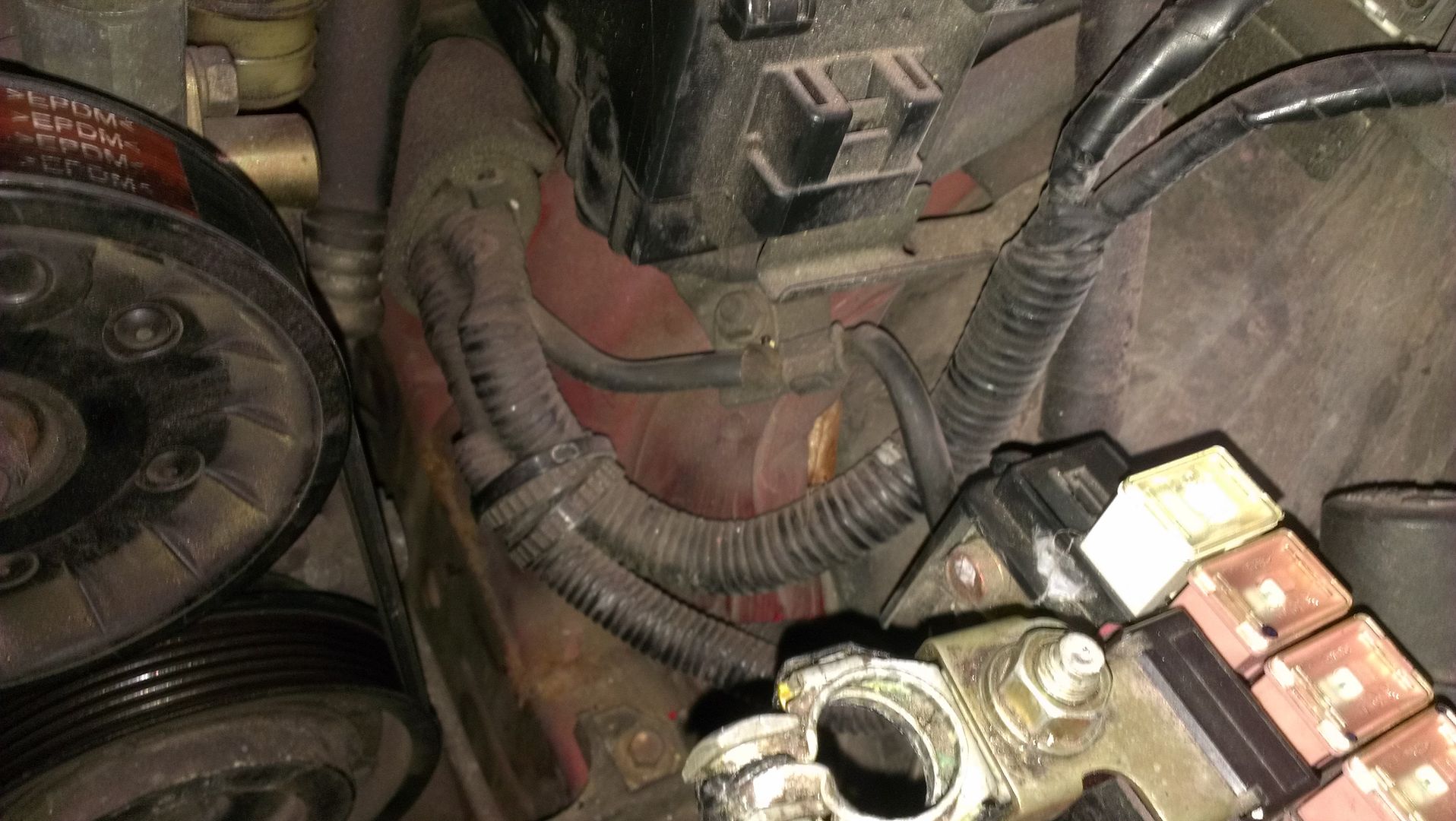
Before disappearing into the loom.
This is the alternator end
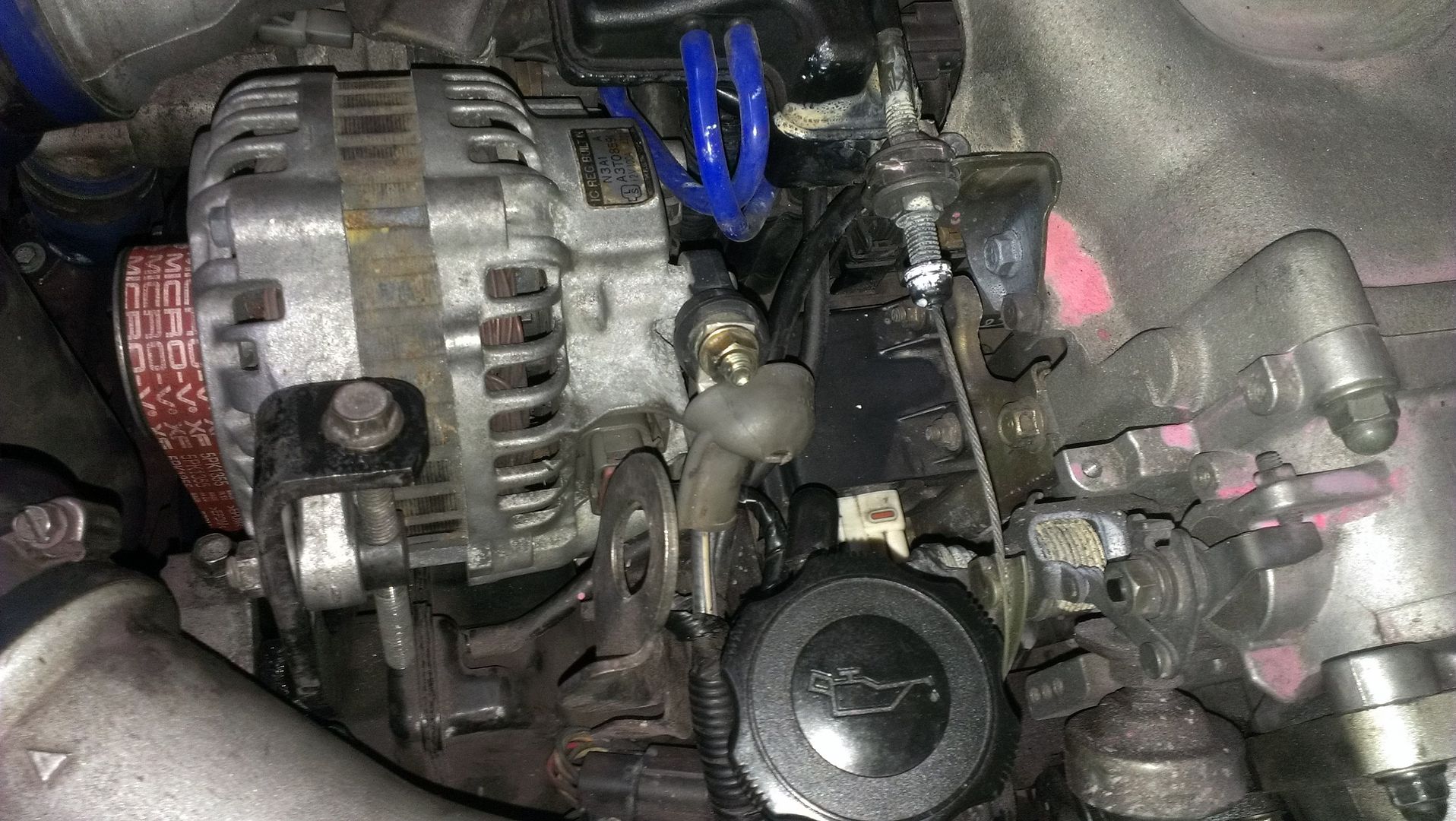
OK onto the voltage checks.
With the ignition off
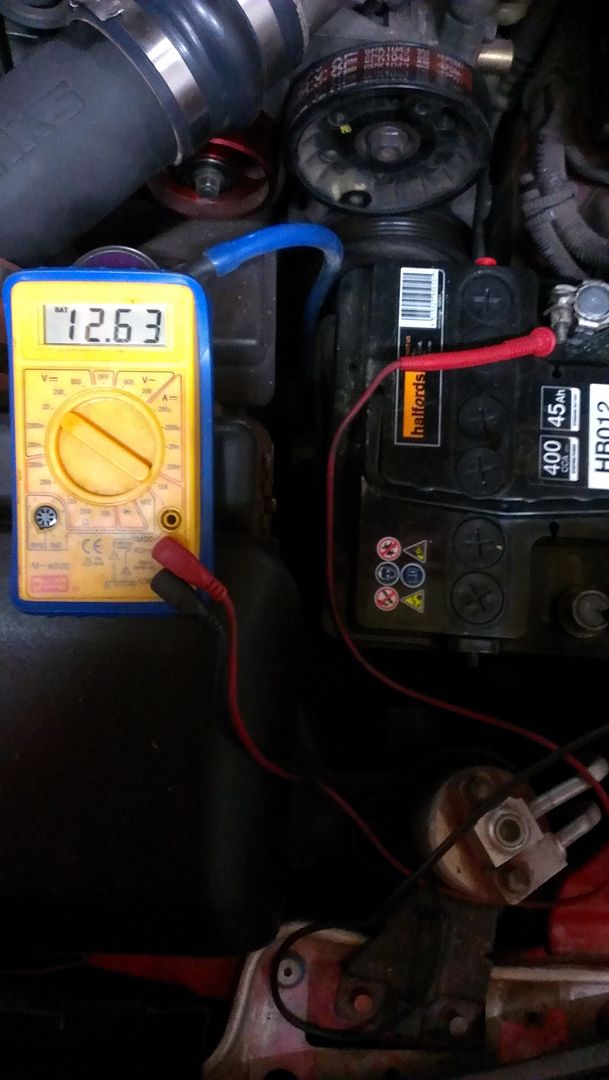
Alternator end

Ignition on

Alternator

I also started the engine up and turned all the lights on etc.
Both the alternator and battery were reading 12.2v.
The warning lights in the car have gone off but then this could be due to the battery now being fully charged.
I will see if the battery has drained again tomorrow and also try the jump lead.
Here is tonights findings. Now I am not too sure how reliable they will be as the battery is now fully charged.

This is the layout of the Battery tray with the negative cable.

It goes off here to the body,

Before disappearing into the loom.
This is the alternator end

OK onto the voltage checks.
With the ignition off

Alternator end

Ignition on

Alternator

I also started the engine up and turned all the lights on etc.
Both the alternator and battery were reading 12.2v.
The warning lights in the car have gone off but then this could be due to the battery now being fully charged.
I will see if the battery has drained again tomorrow and also try the jump lead.
Daston said:
OK guys,
I will admit I am a bit of a beginner when it comes to vehicle electrics but can someone just reassure me here....
I disconnected the negative clamp, put the jump lead on the negative terminal and then went to put the other end onto the alternator connector which resulted in the mother of all sparks. After checking my boxers I decided I would seek your guidance before trying again lol.
The lead on the alternator that has a rubber boot on it is positive. You will most certainly get a big spark if you jump it to earth. I will admit I am a bit of a beginner when it comes to vehicle electrics but can someone just reassure me here....
I disconnected the negative clamp, put the jump lead on the negative terminal and then went to put the other end onto the alternator connector which resulted in the mother of all sparks. After checking my boxers I decided I would seek your guidance before trying again lol.
Gassing Station | Home Mechanics | Top of Page | What's New | My Stuff




